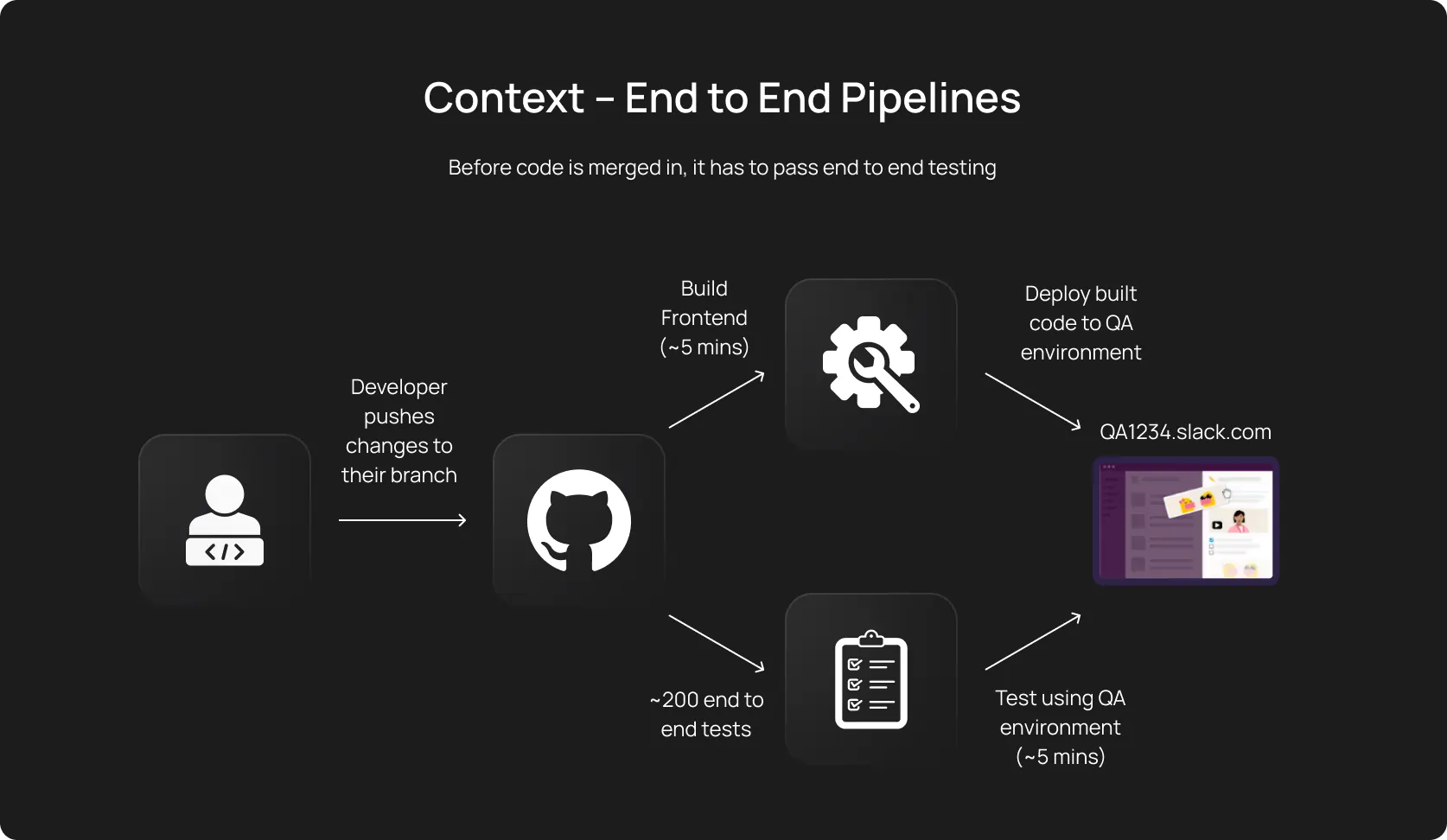How to build an end-to-end testing strategy using AI tools?
Dmitry Reznik
Chief Product Officer

Oct 3, 2025
Updated on Oct 8, 2025
Summarize with:
Where was the last time you lashed out at your team because of a broken release? Or because of any other software/testing-related issue.
You should understand they don’t lack tools or ambition, but are trying to scale yesterday’s processes against today’s complexity. Brittle tests, coverage has significant gaps, time frames stretch, and a poor final product erodes customer trust.
Modern software is API-driven, microservices-based, is shipped daily, and is integrated globally (even if you have a relatively small app). A single user flow usually touches dozens of systems, yet most QA strategies still treat end-to-end as a checklist activity rather than a living safeguard.
Slack’s DevXP team reported they have halved the build times and conditional frontend builds by optimizing their E2E pipeline. Now, they run over 200 tests in just 5 minutes.
Yes, even advanced systems with mature practices hit scaling limits.

What is the foundation of such a modern AI end-to-end testing strategy?
- Smarter coverage through risk-based prioritization
- Resilience via self-healing tests
- Faster feedback through intelligent orchestration
- Richer insights from analyzing failures at scale
This is what we are explaining in this piece. Dive in if you are ready.
What is an end-to-end testing strategy (and why it’s broken today)
End-to-end testing assays complete user journey (from UI clicks to API calls, database writes, and external services) to ensure systems work. Ideally, it simulates real-world usage across all integrated components.
Common issues in E2E strategies:
- Flaky tests: Timing, dynamic data, or environment instability.
- Coverage blind spots: Critical workflows often remain untested, as well as edge cases and integrations
- Long-winded feedback: You don’t know about important bugs until late in the cycle
- Brittle pipelines: Minor UI or backend changes lead to widespread script failures
- Maintenance overload: Teams spend more time updating broken tests than writing new ones
- Signal loss: When thousands of test failures crowd the CI logs, you miss important alerts
- Resource bottlenecks: E2E tests are too slow to run per pull request, and D-1 releases feel dangerous
Insight: Industry reports reveal that 50%+ of QA teams consider flaky tests and poor coverage to be the top E2E challenges. At the same time, manual maintenance takes 20+ hours per sprint in mid-sized companies.
Now, let’s hash out how AI in QA addresses these challenges.
The role of AI across the testing lifecycle
Software development can’t afford to keep E2E regression testing a fragile effort. We should bridge the gap that is widening between technologies and their back-ups in any form, particularly testing. That’s why artificial intelligence comes across as the top-of-mind instrument for this; it’s simply aligned with code delivery velocity.
Tool executes and adapts tests in real time
Modern software development is full of changes, both at the business process level and at the tech SDLC level. Server timeouts and API updates change your typical schedule several times per day. And you have to adapt, because you simply don’t have alternatives.
AI has. A typical E2E suite runs 40% faster when AI dynamically adjusts to a flaky third-party API. Next-gen tools execute tests simultaneously in the cloud, scale up to five threads, and deliver feedback to DevOps teams immediately.
Insight: Many old-fashioned QA tools have static scheduling, while AI tools monitor network requests (for example, catching 4xx/5xx errors) and stabilize execution in real time.
Self-healing ensures regression resilience
You need to change that button placement…and it broke the entire E2E suite. QA automation with AI is still up and running in a similar case. This is because artificial intelligence models used in modern tools have a so-called self-healing, and QA managers can maintain effective E2E suites without actual maintenance efforts.
Reports bring action and clarity
Earlier, the testing strategy had more manual character and looked like this: checking the codebase → aligning it with the required and the upcoming functionality → creating test cases and running them several times → analysis of the current process and the results.
Eventually, the team could decide on the next move or a pivot in strategy.
Nowadays this is much faster. Modern tools deliver insight-packed reports, which are getting more precise with every run.
OwlityAI, for example, provides a clear-cut, visualized report so that the QA team can fix almost any problem in just one sprint. Such insights help CTOs track KPIs and speed up releases.
AI dashboards highlight trends, expected patterns and integrate with project tools.
How to build your AI‑backed E2E testing strategy
AI in QA has several key applications. First, it analyzes every code commit and typical user flows. This allows you to prioritize high-risk areas. Such a predictive approach ensures test architects focus on what really impacts your product.
1. Assess your current flow
- List all E2E user flows. Apart from banal UI and API, make sure to include third-party integrations and databases.
- Log failure rates, repair time, and environment error frequency. Look for patterns (a third of failures are usually caused by locator changes. This is a prime example).
- Measure pipeline times and calculate maintenance costs. Move insights from QA tools to Jira tickets for visibility.
How-to: Zephyr/Jira → export test execution logs → cross-reference with Git commit logs = you will spot areas with the highest churn and that need AI prioritization.
This may be payment APIs or another area, depending on your business niche or tech flows.
2. Move step by step
Don’t rush. The gradual approach is the most effective.
Below is just a rough example. We aimed to illustrate possible steps. Precise phases depend on your business, the size of your tech team, and many other aspects.
- Stage 1: AI test case generation → Point the tool at logs, analytics, or usage data → AI proposes 80/20 test sets.
- Stage 2: Self‑healing scripts → Activate locator-fallbacks and make tool autonomously retry tests → The tool manages at least a quarter of test fix.
Tip: Choose a single user flow (let’s say login-to-checkout or user settings) and start a pilot using a tool with computer vision. Validate coverage against manual tests. Scale once you have tangible and suitable results.
3. Make KPIs mirroring AI benefits
Create measurable targets:
- Reduce E2E test maintenance effort (in time spent) by XX% in X sprints
- Decrease pipeline runtime by XX% maintaining XX% and higher coverage
- Keep the flaky test rate under X%
Use a dashboard to create internal benchmarks for current E2E runtimes and defect escape rates. Share weekly KPI reports with leadership to secure buy-in for AI expansion.
4. Set up a relevant AI tool
Look for tools that can:
- Retrieve logs and pipeline metrics via CI/CD APIs
- Auto-generate, self-heal, and execute smart E2E tests
- Provide dashboards for key parameters: flaky detection, failure trends, root-cause hints
Checklist
- Spot 3 to 5 user flows that constantly fail
- Choose one E2E layer. For example, regression testing, where AI can bring the most value.
- Check script quality with dev/QA review
- Start using self-healing, if everything is fine
- Automate test triggers on pull requests
- Measure maintenance, runtime, and coverage metrics weekly
Common pitfalls when adopting AI in QA (and what to do instead)
Don’t consider QA automation with AI as a silver bullet. Such a perception is probably the most common mistake. Below, we have listed four more that inflate costs and break AI’s reputation, by the way.
AI isn’t a silver bullet. Its outputs are not flawless and can lead to missed defects. Don’t trust it blindly: SDETs should validate 10-20% of AI test cases weekly, ensuring edge cases (e.g., invalid inputs) are covered.
AI needs context to deliver properly. Using generic or outdated data produces irrelevant tests. Instead, enable AI with recent Jira defect data, user session logs, and Git commits to align tests with real-world usage. As we said before, you can also generate data for model training. And some of these tools (generating data) are really helpful, but you should consider their cost and the bottom line of such a move.
AI doesn’t replace expertise. Over-automating skips critical human insight. QA leads should schedule biweekly reviews to refine AI-generated tests, blending automation with exploratory testing.
Bottom line
Refining your end-to-end testing strategy, make sure to tie your changes to business goals. The key thing here is not to just implement AI testing tools, the thing is to do this safely and in a strictly trackable way.
The most robust business is the one that is standing on data.
This is why you need to think about quality data for your AI tool, then — the entry point (where artificial intelligence will bring the most value). And only after that, you can choose a relevant tool and calibrate the testing process properly.
If you need expert help, book a free 30-min demo with OwlityAI’s team.
Monthly testing & QA content in your inbox
Get the latest product updates, news, and customer stories delivered directly to your inbox